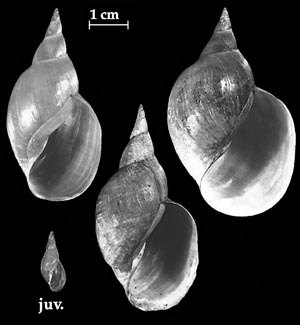Freshwater snails » Shell shape » Shell taller than wide » Dextral shell » Family: Lymnaeidae (1) » Lymnaeidae with short spires (2) » Lymnaeidae with tall spires (3) »
The shells of this family do not possess an operculum. Many empty freshwater snail shells may be found without an operculum. If your specimen does not have an operculum and does not match the shape and / or descriptions on the following pages, please go back and try the group with an operculum.
Five species of the family have taller spires. "Taller" is a difficult term to define. The best that can be said is that the spire is taller than the very short spires of Myxas glutinosa and Radix auricularia seen on the "short spires" page.

Lymnaea stagnalis
(Linnaeus, 1758)
Lymnaea stagnalis (Linnaeus, 1758)
Description: The shell is rather thin and horn-coloured. There are 7 – 7½ whorls which expand only gradually at first, but the body whorl is very large and bulging, and comprises about three-quarters of the total height of the shell. The spire is long and tapers to a point. The umbilicus is completely closed. The mouth aperture is roughly pear-shaped.
Size: Height: 35 – 50 mm. Breadth: 18 – 28 mm.
Habitat: It is found in slow-flowing rivers, canals, ponds and lakes, throughout the British Isles. It is a carrion eater, feeding upon dead animal matter, although it is said to attack living fish and newts.

Omphiscola glabra
(Müller, 1774)
Genus: OMPHISCOLA Beck, 1837
Only one species occurs in Britain.
Omphiscola glabra (Müller, 1774)
Description: The shell is nearly cylindrical in shape, and glossy. It is usually horn-coloured and formed of 7 – 8 gradually enlarging whorls with a blunt apex to the spire. The body whorl forms about half the height of the shell. The umbilicus is hardly visible. The mouth aperture is small and pear shaped.
Size: Height: 9 – 12 mm. Breadth: 3 – 4 mm.
Habitat: It occurs in soft water ditches and pools on acid soils such as heaths, often in places which dry out in summer. It was formerly quite widely distributed, but it is under threat from drainage of boggy areas, and conversely, by deepening of small seasonal pools to convert them to permanent ponds.
